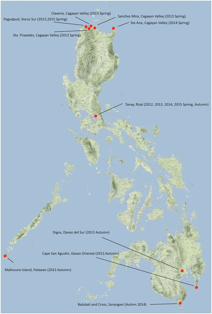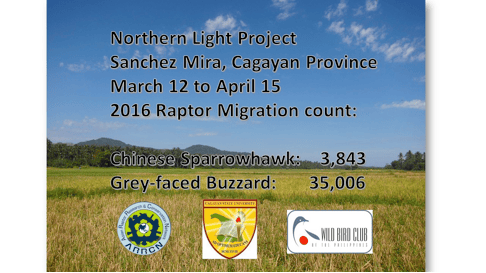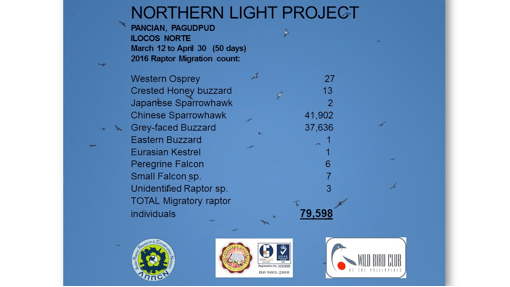by Alex Tiongco and Teresa Cervero
The Philippines has on record 32 species of raptors:-
6 endemic species
Philippine Eagle (Pythecophaga jefferyi)
Philippine Honey-buzzard (Pernis steerei)
Philippine Serpent eagle (Spilornis holospilus)
Philippine Hawk-eagle (Nisaetus philippensis)
Pinsker’s Hawk-eagle (Nisaetus pinskeri)
Philippine Falconet (Microhierax erythrogenys)
11 sedentary species
Jerdon’s Baza (Aviceda jerdoni)
Black-shouldered Kite (Elanus caeruleus)
Brahminy Kite (Haliastur indus)
White-bellied Sea-eagle (Haliaeetus leucogaster)
Grey-headed Fish-eagle (Ichthyophaga ichthyaetus)
Besra (Accipiter virgatus)
Crested Goshawk (Accipiter trivirgatus)
Crested Serpent-eagle (Spilornis cheela)
Rufous-bellied Hawk-eagle (Lophotriorchis kienerii)
Changeable Hawk-eagle (Nisaetus cirrhatus)
Oriental Hobby (Falco severus)
10 pure migratory species
Black Kite (Milvus migrans)
Eastern Marsh-Harrier (Circus spilonotus)is)
Japanese Sparrowhawk (Accipiter gularis)
Chinese Sparrowhawk (Accipiter soloensis)
Grey-faced Buzzard (Butastur indicus)
Eurasian Kestrel (Falco tinnunculus)
Merlin (Falco columbarius)
Eurasian Hobby (Falco subbuteo)
Amur Falcon (Falco amurensis)
Cinereous Vulture (Aegypius monachus)
5 migratory species with sedentary population
Western Osprey (Pandion haliaetus)
Crested Honey-buzzard (Pernis ptilorhynchus)
Pied Harrier (Cirus melanoleucos)
Eastern Buzzard (Buteo japonicus)
Peregrine Falcon (Falco peregrinus)
There were 2 important changes in the raptor classification in 2014/2015, based on the WBCP Checklist as of January 2015:-
- The Amur Falcon (Falco amurensis) was added to the Philippine record increasing the number of raptor species reported in the Philippines to 32 after a single individual was photographed in Northern Philippines and
- The Eastern Buzzard (Buteo japonicus) is now considered a migratory species with resident population after a nesting Eastern Buzzard was discovered also on Northern Luzon.
Except for the Philippine Eagle, raptor species in the Philippines have been grossly understudied.
Raptor Migration Monitoring
East Asia has 2 major raptor migration flyway – the East Asian Continental Flyway and the East Asian Oceanic Flyway where the Philippines is an important hub.
Raptor migration in the Oceanic Flyway involves vast sea crossings and is influenced greatly by monsoon winds: the Northeast Monsoon affecting the Spring migration (March and April) and the Southwest Monsoon involving Autumn migration (September and October). However, the many typhoons which occur during migration seasons could also exert tremendous but yet largely unknown effect on the flight and plight of migrating raptors.
Every year, thousands of raptors come to winter in the Philippines or simply pass through, but their species, numbers, routes and migration ecology have not been systematically studied.
Up until recently, raptor migration watch was non-existent in the Philippines. In 2004 a raptor migration flight path was discovered at Tanay on southern Luzon which became the habitual raptor watch site for the Wild Bird Club of the Philippines. Occasional spring and autumn watches conducted there produced great records and flight information spurring a small group of members of the club, with the assistance of the ARRCN, and neighbouring countries, Malaysia, Thailand, Taiwan and Indonesia to take up the challenge for structured studies on Raptor Migration.
A series of field work over the last 3 years have been undertaken in other areas around the Philippines to determine:
1) the exit, entry and obligatory converging points migratory raptors use,
2) the routes they take in their journey over the various islands in the Philippines,
3) the wintering and roosting places.
The original objective of the WBCP Raptor Group was simply to establish a data base regarding species, numbers, routes, habitats of migrating raptors.
Studies were conducted at the following sites:
 Sanchez Mira, Cagayan Valley (2013, 2016 Spring)
Sanchez Mira, Cagayan Valley (2013, 2016 Spring)- Claveria, Cagayan Valley (2013 Spring)
- Sta.Praxedes, Cagayan Valley (2013 Spring)
- Pagudpud, Ilocos Sur (2013, 2015, 2016 Spring)
- Tanay, Rizal (yearly since 2004, Spring, Autumn)
- Malinsuno Island, Palawan (2013 Autumn)
- Digos Davao del Sur, (2013 Autumn)
- Cape San Agustin, Davao Oriental, (2013 Autumn)
- Sta Ana, Cagayan Valley (2014 Spring)
- Batulaki and Cross, Sarangani (Autumn 2014)
Many other sites were investigated which need further and longer observations.
Additionally, raptor sighting reports from club members are regularly harvested to form part of the overall information regarding presence and movement of raptors in the Philippines.
Vital discoveries have been made and significant data obtained which could help form an overall picture on the raptor migration phenomenon in the Philippines:
The results of the month long studies at Batulaki and Cross at Sarangani (Autumn 2014) and Cape San Agustin, Davao Oriental, (Autumn 2013) were published at BirdingAsia, no.24, December 2015. This study confirms the passage of thousands of Chinese Sparrowhawks through Cape San Agustin, on Davao Oriental and Cross, Glan on Sarangani from September-October enroute to Indonesia. The migratory raptors presumably cross the seas through the Sarangani Strait.
The results of the first ever full season migration watch conducted at Pancian, Pagudpud, Ilocos Norte (Spring 2015) which have just been published at eBon.
At the 9th ARRCN Raptor Symposium at Chumphon, members of the club and the Philippine Eagle Foundation PEF made 6 paper and poster presentations on Philippine Raptors which was so far the biggest representation in any ARRCN Raptor symposium.

As the studies progressed and information flowed in, it was realized that a small group of hobbyists running around the breadth and depth of the country could not sustain the project’s viability.
The upsurge of information and the immensity of information still to be obtained and the depth of its analysis require that more people be engaged. It was decided to encourage students and communities along the discovered flyways to be involved to carry on the studies.
Northern Luzon, The current area of study for spring migration
Northern Luzon has been known to be the jump off area for raptors leaving for their breeding areas in the Palearctic (Japan, China, etc) for spring (March, April).
The group’s early forays to the north resulted in the following initial discoveries:-
1) An important spring roosting area for Grey-faced Buzzards at Sanchez Mira, Cagayan Valley. (2013). Roosting areas are considered extremely important in raptor studies as they hold the secrets behind the species phenology.
2) A migratory flyway was traced westward from Sanchez Mira to Claveria to Sta Praxedes (all at Cagayan Province) and Pagudpud, Ilocos Norte. The first ever full season spring watch was conducted in 2015 on the obligatory spring converging flyway and lands-end at Pancian, Pagudpud, Ilocos Norte. (2013, 2015).
With these important discoveries the Raptor Group and the ARRCN decided to concentrate their resources and manpower in the northern areas of the Philippines for the spring season in order to pinpoint areas where these raptors can best be monitored and studied. But the more important aim is to encourage schools and universities and the LGUs to incorporate raptor studies into their continuing research and conservation programs.
In line with this spring program, yearly, for the last 3 years, seminars have been conducted by the ARRCN and the Raptor Group at Sanchez Mira, Adams, Pancian and Laoag. Fliers on raptor migration, educational materials, monitoring equipment (binoculars and spotting scopes) have been regularly distributed to the communities and the universities from personal donations from club members, the ARRCN and its sponsors.



This year, the Cagayan State University- Sanchez Mira and the Northwestern University of Laoag have agreed to take on the challenge; so have the communities of Pagudpud and Adams. More communities and groups are slated to join next year’s (2017) projects.
Projects completed for Spring 2016:
Sanchez Mira, Cagayan Valley
1) Conservation forum held at CSU attended by students, the LGU and the DENR on March 21, 2016 facilitated by Dr. Carmela Espanola. Prior to the forum, talks were done by Trinket Canlas, Toru Yamazaki, Michael Calaramo, Forester Florendo Serra and the special guest speaker — Executive Director of the Philippine Eagle Foundation, Dennis Salvador.
2) First roosting density count on the Greyfaced Buzzard was conducted by students of CSU Sanchez in cooperation with the ARRCN and the WBCP Raptor group 12March- 15April.
3) Dr. Lala Espanola and Jelaine Gan (U.P. Institute of Biology) in cooperation with CSU-Sanchez Mira and the ARRCN, have completed their field research on “Prey composition, population density and the hunting of migratory Grey-faced Buzzards in Sanchez Mira”.
With the first ever roosting density study, Cagayan State University incorporated the Raptor Study program into their Education Extension Program. The University will continue to conduct yearly density counts on the roosting sites, and conduct studies in furtherance to the project started by Dr. Lala and Jelaine to determine the beneficial effect of the seasonal presence of roosting raptors to coconut plantations and rice fields of northern Luzon.
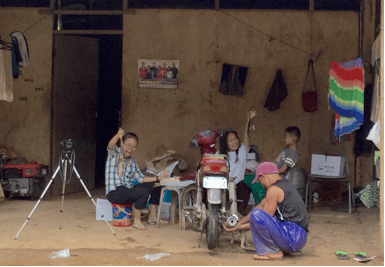
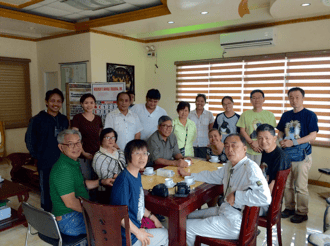

the health of the environment; as well as benefits derived by the farmers in protecting the Grey-faced Buzzard.


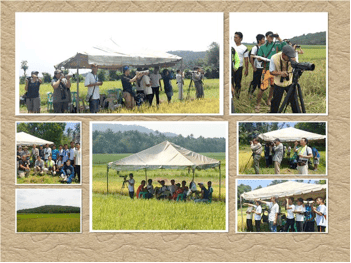
Pancian, Ilocos Norte
- A research team from Northwestern University in coordination with the Asian Raptor Research & Conservation Network (ARRCN) and the Raptor Group conducted another full season watch from 12th March to 30th April at Pannzian Beach resort to validate last year’s (2015) findings. The research group came up with a count surpassing last year’s count confirming that Pagudpud is indeed an important raptor migratory flyway. Two migratory raptor species were added to the record at Pannzian:- the Eurasian Kestrel (Falco tinnunculus) and the Common Buzzard (Buteo japonicus). Small falcon species continue to defy identification. There was no sighting of the Black Kite (Milvus migrans) this time.
- To coincide with the Northern Luzon visit of the (ARRCN) team led by Toru Yamazaki from 19 March to 24 March, the Raptor Group conducted a Conservation Forum at Pannzian, facilitated by Dr. Carmela Espanola, Trinket Canlas, Jelaine Gan and Maia Tanedo. Prior to the group discussions, talks were done by Trinket Canlas on birdwatching basics; Dr. Toru Yamazaki on Grey-faced Buzzard Conservation; Michael Calaramo on the natural heritage of Northern Luzon; and Dr. Carmela Espanola on the threats on biodiversity.
- Minor roosting sites for Greyfaced Buzzards have been discovered at Barangays Pasaleng and Pancian.
- The forested areas of the Kalbario-Patapat ranges which has been discovered to be home of 8 species of resident raptors are currently being explored by the research team for areas for raptor study.


and community members of Pancian, Pasaleng and Balaoi.

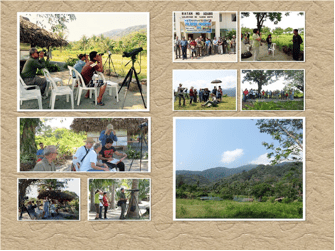
Adams on 19 March with ARRCN).
Plans for 2016 Autumn Migration (Project Southern Cross)
The ARRCN and the Raptor Group intends to continue the monitoring studies at Cape San Agustin, Davao Oriental and at Cross, Glan, Sarangani which were started in 2013 and 2014 respectively. The Philippine Eagle Foundation has agreed to have a major involvement of the project, which is very convenient indeed because the distance between the two watch sites involves more than 12 hours travel each way.
The Autumn watches on Mindanao will be patterned after the Northern Light project in Northern Philippines which is empowering the local communities and Universities to be the movers of the studies.
We still have to determine which Universities would like to commit to Project Southern Cross .
The Governor of Sarangani who supported the 2014 watch at Barangay Cross has pledged greater support for the 2016 Autumn raptor migration watch.
Details of the project will be announced when finalized.
Plans for 2017
Northern Light Spring 2017
1. Sanchez Mira, Cagayan Valley
The Cagayan State University, in coordination with the ARRCN, the LGUs of Sanchez Mira, MASCOOP – a Farmers cooperative with memberships covering the area from Claveria to Tuguegarao are planning to hold an educational campaign for the protection of the Greyfaced Buzzards. The LGU’s of nearby municipalities like Claveria and Pamplona will be invited to take part. The campaign is slated to start in late January, a month before the migration season.
The educational campaign will be capped with a Raptorwatch Festival held in the campus of Cagayan State University which is directly under the flyway.
2. Pannzian, Pagudpud, Ilocos Norte
The Northwestern University research team will spearhead the monitoring for 2016. Since the campus of NWU is about 2 hours away from the watch site, the team will utilise students from the schools of Barangays Pasaleng, Pancian and Balaoi as part of the educational program to foster the awareness of raptors to students and the community.
The search for major roosting, and nesting sites in the vicinity of Adams and Mt. Palemlem will continue.
We are optimistic the educational campaign and raptor migration monitoring studies which have been conducted in the past 3 years and the continuance of the “Northern Light” project will not only promote increased awareness of the richness of the environment and basic understanding of the ecosystem but instil the love for our natural heritage in the hearts of the community members. Then, perhaps, the conservation efforts will reap benefits for everyone.
Acknowledgments:
Our heartfelt thanks goes out to all those who watched with us and have assisted us in so many ways:
The ARRCN team & other Japanese conservation groups:
Toru Yamazaki
Atsuko Yamazaki
Yasunori Nitani
Tatsuyoshi Murate
Michiyo Murate
Atsuki Azuma
Seiichi Dejima
Takashi Fujii
Yasunobu Komoriya
Takumi Yamazaki
Suntory Whiskey which financed the student watches.
Pannzian Beach & Mountain Resort owners: Ms. Corazon Alonso and her son Ken Alonso
Wild Bird Club of the Philippines members:
Patty Adversario
Lu-Ann Bajarias
Mads Bajarias
Carmela Balcazar
Adri Constantino
Trinket Constantino
Chary Dino (and her assistants: Miracle Contreras & videographer Aristeo Joseph Valdez, Jr.)
Dr. Carmela Espanola
Jelaine Gan
Nicky Icarangal
Vincent Lao
Charo Lim
Ixi Mapua
Mikeli Mapua
Jun Osano
Alan Pascua
Richard Ruiz
Jude Sanchez
Maia Tanedo
Melanie Tan
Mark Villa
Wild Bird Club of Laoag:
Petrus Calope
Dennis Jakoboski
Philippine Eagle Foundation:
Dennis J.I. Salvador
The NWU team:
Northwestern University V.P. Liza Nicolas; Michael Calaramo Director of the NUEBG; researchers: Anthony Ramil, Alvin Valdez, Rey Valdez, Jeorge Failano, Venus Palting
Cagayan State University – Sanchez Mira team:
CEO Froilan Pacris, Research & Dev Dept. & other Faculty members: Dr. Susan Matipo, Lorna Illustrisimo; Elmer Bagasol ; Elimar Doca, Paul Mapala and the students and personnel of CSU – Sanchez Mira who participated in the raptor migration monitoring.


